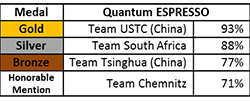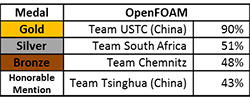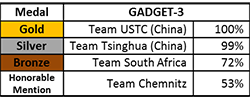Hyperbole aside, this article and the ones following it are the most comprehensive and in-depth analysis of a cluster competition that the world has ever seen. If you can find better coverage, then I’ll eat a handful of spider webs. Clunk! (That ‘clunk’ was the sound of me dropping my keyboard to the floor, rapper style, and stalking out of the room. I’m back now.)
That said, let’s dive into the results from the benchmarks and HPC application portion of the ISC’14 Student Cluster Competition…
HPCC: Like “Hotel California” at an Eagles concert, <HPCC (HPC Challenge Benchmark Suite) is a staple of student cluster competitions.
The suite is a combination of seven well-known HPC benchmarks including: HPL (LINPACK), STREAM, PTRANS, FFTE, DGEMM, RandomAccess, and b.eff (which isn’t capitalized; I wonder why? Modesty, maybe?)
 One of the ISC’14 newbie teams, USTC (University of Science and Technology of China), pulled down a perfect 100% maximum score on HPCC, which is a damned good performance. Team sponsor Sugon (also new to the student cluster world) has to be feeling good about backing the USTC kids. The average score for all teams on HPCC was 58%.
One of the ISC’14 newbie teams, USTC (University of Science and Technology of China), pulled down a perfect 100% maximum score on HPCC, which is a damned good performance. Team sponsor Sugon (also new to the student cluster world) has to be feeling good about backing the USTC kids. The average score for all teams on HPCC was 58%.
Team Hamburg was definitely hitting above their weight with their second-place finish. Given their traditional CPU-based cluster and relative lack of competition experience, they did amazingly well on this benchmark.
South Africa snuck ahead of Mass Green for the Bronze Medal. Mass Green gets an Honorable Mention for driving their quad-socket, fat-node monster cluster into fourth place, topping seven other teams with more conventional clusters.
Quantum ESPRESSO is a set of open source codes that are used to calculate materials modeling at extremely small scale. We’ve seen this app a couple of times in other competitions, and it’s caused some problems for teams in the past.
But this crop of student clusterers seemed to handle it in stride, with almost every team posting a valid score. The average score for all teams on this app was around 50%.
GPU-enabled versions of QE are available, which was pretty helpful for those teams driving NVIDIA accelerators.
 Once again Team USTC was a standout, grabbing 93% of the points possible on this app. South Africa was close on their heels, only five points back. Team Tsinghua managed to nab the Bronze Medal, even though they didn’t have any accelerators in their system – meaning they had to optimize the living hell out of the app in order to top the rest of the field.
Once again Team USTC was a standout, grabbing 93% of the points possible on this app. South Africa was close on their heels, only five points back. Team Tsinghua managed to nab the Bronze Medal, even though they didn’t have any accelerators in their system – meaning they had to optimize the living hell out of the app in order to top the rest of the field.
Home team Chemnitz gets the nod for Honorable Mention, that’s a good score on a tough application.
OpenFOAM is a set of solvers that are often used to model fluid dynamics. You could use it to figure out airflow through a turbine or to model the pressure differential in your lawn sprinkler system.
There are GPU-friendly versions of OpenFOAM available. Depending on the problem and solvers being used, GPUs can provide a 50%+ speed-up while using a third less energy – definitely a competitive advantage in student cluster wars.
We saw a wide range of scores on OpenFOAM this year, with the average score at 32%, making OpenFOAM one of the most challenging apps in the ISC’14 competition.
 Once again, that plucky team from USTC nabbed a Gold Medal on this app, topping the ten other competitors by a wide margin. South Africa took the Silver, andTeam Chemnitz finished with a Bronze Medal. Tsinghua gets Honorable Mention for posting a score competitive with the field, without the benefit of accelerators.
Once again, that plucky team from USTC nabbed a Gold Medal on this app, topping the ten other competitors by a wide margin. South Africa took the Silver, andTeam Chemnitz finished with a Bronze Medal. Tsinghua gets Honorable Mention for posting a score competitive with the field, without the benefit of accelerators.
GADGET-3: Like I’ve said many times before, if I were forced to model the universe and could only select one software package, I’d take GADGET-3, hands down.
It’ll do your gravitational force modeling and even show you what happens when galaxies collide – which takes a fair amount of computational power.
GADGET-3 was another tough app for the student teams (the average score was 40%). However, all of them turned in a valid result, meaning that they were able to set up and finish at least one run.
Team USTC adds to their Gold Medal count with a field-topping 100% score. Team Tsinghua missed first place by a heartbreaking one percentage point margin, settling for the silver.
 Former ISC champion South Africa led the rest of the field and took the bronze with their score of 72%. Home team Chemnitz nailed down another Honorable Mention for their fourth place finish on what proved to be a very difficult application.
Former ISC champion South Africa led the rest of the field and took the bronze with their score of 72%. Home team Chemnitz nailed down another Honorable Mention for their fourth place finish on what proved to be a very difficult application.
In the next article, we’ll cover results from the dreaded “Mystery Application”, the “Secret Mission” task, and the interview components of the competition. And then full coverage of the winners… stay tuned…
Posted In: Latest News, ISC 2014 Leipzig
Tagged: supercomputing, Student Cluster Competition, HPC, University of Science and Technology of China, Tsinghua University, Chemnitz University of Technology, Centre for High Performance Computing, ISC 2014, University of Hamburg, Massachusetts Green Team, Meet the teams





Student_C_C
·
More #ISC14: app deep dive http://t.co/2aU61jItga @ustc @unihh #CHPC @Tsinghua_China @TUChemnitz @bentleyu @MITEECS @Northeastern